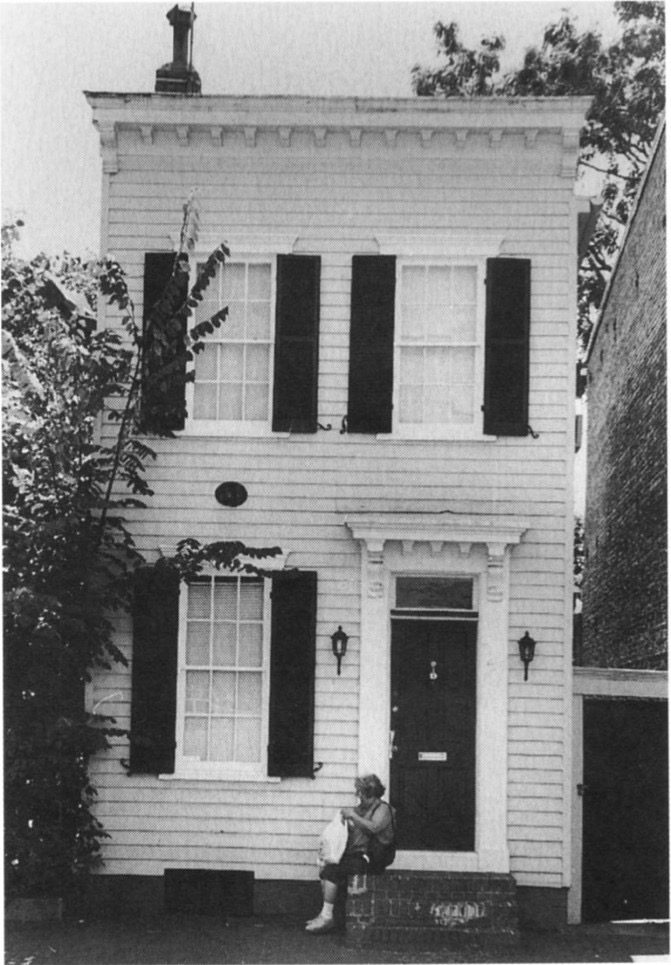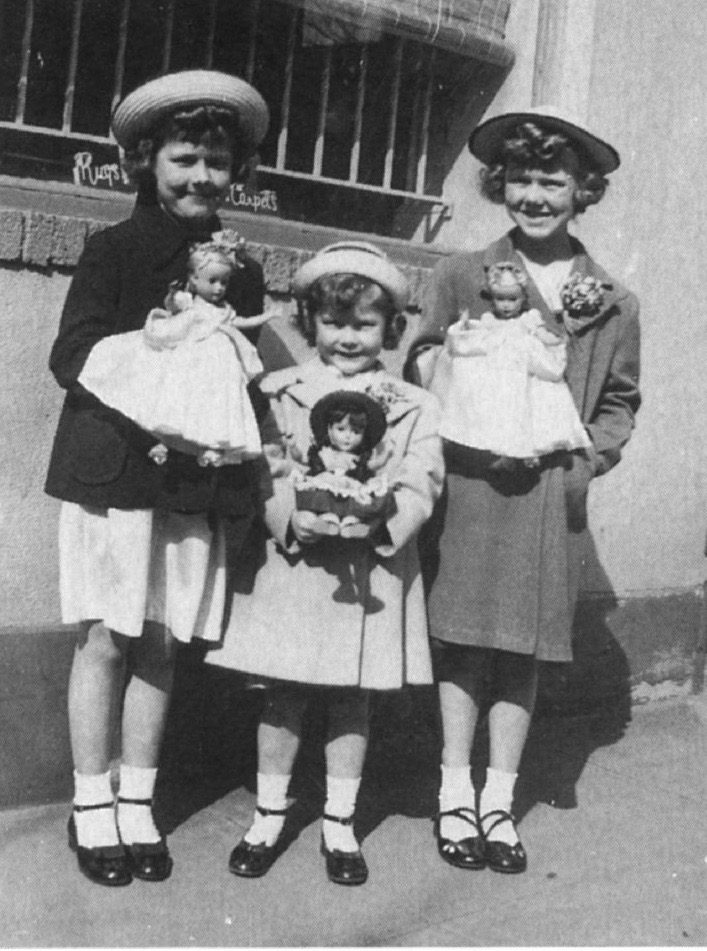Mapping Georgetown: An Inspiring and Revealing Childhood Story
By • January 3, 2022 2 2103

Whenever I tell people I grew up in Georgetown, they assume I was born into money. Nothing could be further from the truth….
Since we had no electricity, we didn’t have a television, but few people did in the early 1950s…
— Barbara Liegus
Stories of childhood memories and growing up in Georgetown always catch my eye. But these recollections from Barbara (Bobbie Liegus) submitted to our Mapping Georgetown project are so inspiring as they vividly transport us back to her tough but happy childhood growing up with a single mom and two sisters on the other-side-of-the-tracks in Georgetown in the 1950s.
Liegus’s historical recollections are so insightful, the Historical Society of Washington D.C. published her article “A Georgetown Childhood in Mid-Century” in the fall/winter 1996/97 edition of their magazine Washington History. It can be seen here.
Reading through her reminiscenses is like a journey through an Amor Towles novel, “A Gentleman in Moscow” or “The Lincoln Highway,” only her captivating memories of growing up in Georgetown are not only novel, but true.
Here is the map-story Liegus submitted to the Mapping Georgetown project:
“I grew up at 3240 Q St. NW, went to Hyde Elementary School and St. John’s Episcopal Church. My mom was a single mother raising three girls on her own. She rented the house we lived in… it had no electricity and we used kerosene lamps and coal stoves. This was in the late ’40s and early ’50s. When I was about twelve, we moved to Glover Park into a one-bedroom apartment (for the four of us). We thought we were in Heaven… we had electricity! I wrote an article entitled, “A Georgetown Childhood in Mid-Century,” which was published in the Magazine of The Historical Society of Washington, DC, Fall/Winter 1996-97.”
– Barbara Liegus, Oct. 20, 2021
Here are some of Liegus’s recollections from “A Georgetown Childhood in Mid-Century”:
I first heard it when I was out of school and had just started working: native Washingtonians are rare. I didn’t realize it when I was growing up, because everyone I knew was from Washington. I think even rarer is that I’m a native of Georgetown. And rarer still, so was my mother. I am a second-generation Washingtonian, born in George Washington University Hospital, then located on H Street N.W. My mother was born in Columbia Hospital for Women, at 24th and L streets, NW where it is located today….
The house is still there, standing as an ancient woman in heavy makeup, trying desperately to hide her age. But I know what she really looks like underneath….

In August 1996, Georgetown resident Florence Batuto waits for the Metrobus on the front steps of 3240 Q Street, NW, where the Habercoms lived from 1946 to 1953. At that time the family never used the front door, in part because bus riders often occupied their stoop. Photo from Liegus’s article “A Georgetown Childhood in Mid-Century.” Caption from Historical Society of Washington.
Anna Liegus Habercom, my mother, was proud of the fact that she had been born in Washington and raised in Georgetown. Her mother and father had come from Lithuania in the early part of the twentieth century and had separated when my mother and her sister, Mary, were very young. My grandmother Mary Liegus was a cook at the White House during the Coolidge Administration. My grandfather Walter Liegus was in the Army and served during World War I. He died before I was born, and I didn’t know my grandmother until I was an adult because she and my mother were not close.
My mother and her sister had been shuffled between children’s homes and foster care throughout their early childhood. These orphanages sheltered children who had no other place to live, regardless of whether or not their parents were alive. According to my aunt, the last children’s home they lived in burned down, so one of the women who volunteered there asked her sister to take in Mary and Anna. The sister reluctantly agreed to keep them temporarily. Thus, they came to Georgetown around 1924 to live with a Mr. Jenkins, the woman they called “Nanny,” in the gray frame house at 3240 Q Street, the same house in which my mother grew up and where I later spent the majority of my childhood. Temporary turned to permanent, and Nanny raised the girls until they were grown. Mother always told me that Nanny loved me very much, but I was so young when Nanny died, I don’t remember much about her. I do remember the chickens in her chicken yard.

Bobbie, Susan, and Alana Habercom pose for an Easter portrait in 1951. Despite their home’s lack of electricity and plumbing, Anna Habercom’s daughters were always well turned out. Courtesy, the author. Caption by Historical Society of Washington DC.
My early years, from 1941 to 1946, were spent in housing projects in Southeast Washington — Lily Ponds and Bellevue. My father, Guy Habercom, was a sailor stationed at the Navy Yard. He was eventually sent to the South Pacific, and my mother, pregnant with my youngest sister, Susan, took us to Hagerstown, Maryland, to stay with my father’s sister. After the war, my parents soon divorced, and in 1946 my mother returned to Georgetown to the house where she grew up to raise her three little girls alone….
Whenever I tell people I grew up in Georgetown, they assume that I was born into money. Nothing could be further from the truth. In those days, Georgetown was a mixture of the very poor and the very wealthy, and although they existed side by side, they were in reality many miles apart.
According to the 1950 Census, of the 1663 occupied dwelling in Georgetown, 226 had no private bath and 135 had no running water. Our house at 3240 Q Street was one of these, and we also had no electricity…
Despite the poverty, Mother saw to it that we had things that other children had. Among them were tap-dancing lessons taught by Miriam Sellers at her home on Dent Place for 50 cents a class. Mother also let us join the Brownies and Girl Scouts, although I’m sure even the small costs involved stretched her meager finances….
Although Mother’s life revolved around her three daughters, she did have a life of her own. She loved to bowl and competed a couple evenings a week while one of the neighborhood teenagers babysat for us. I loved watching her get ready to go out, because she always smelled so sweet and looked so shiny in her freshly pressed bowling blouse and skirt. She was a top-ranked woman duckpin bowler in the District of Columbia, and she won many awards and trophies. She often had her name and her picture in the paper for her bowling….
Since we had no electricity, we didn’t have a television, but few people did in the early 1950s. However, a family down the street bought one, and the neighborhood kids would gather on their front porch and watch through the windows. Once in a while we’d be invited in to watch, but not very often. In those days, people watched TV in total darkness on very small black and white screens, so it was probably just as well for the sake of our eyes…. Instead we listened to our radio— programs such as The Shadow; Mr. Kean, Tracer of Lost Persons; The FBI in Peace and War; Amos ’n’ Andy; Jack Benny; The Great Gildersleeve; The Life of Riley; and soap operas.
—
Bobbie Liegus may have felt “poor” as one of three supported by a single mom, but she made up for it by constantly competing as a child for local writing contests. Her stories are gifts as a result of time well spent.
“Time well spent leads to life well lived” and Bobbie is a perfect example. She is a beautiful person with a lovely family who has had the opportunity to travel the world in her adult life. She lives in her own home in Alexandria, Virginia. Her mother is to be commended for demonstrating such wisdom as a parent.
We are very grateful to you, Bobbie, for so generously sharing your time and talent with us. We are also most thankful to the Historical Society of Washington D.C. for printing this valuable local history story. Thank you!
To learn more about the Mapping Georgetown project see https://georgetowner.com/articles/2021/07/19/marilyn-butlers-vision-for-mapping-georgetown/.
To submit your Georgetown recollections to Mapping Georgetown go to www.mappinggeorgetown.com or visit the Georgetown Public Library to pick up a physical map-story form to fill out.
Marilyn Butler can be reached at marilyn.butler@gmail.com.


Remarkable story from the remarkable woman who lived it.
I just came across this moving and so well written story and I am grateful to you, Bobbie Liegus for sharing it with the world! I would enjoy meeting you someday and thanking you in person! I grew up on lower MacArthur Blvd near Canal and Foxhall roads.